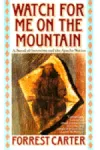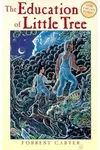Picture a Southern storyteller who spun tales of outlaws and Native American wisdom, only to reveal a past as complex as his plots—meet Forrest Carter! Born Asa Earl Carter, this controversial author traded a life of segregationist rhetoric for a pen that crafted beloved Westerns and a faux memoir that captivated millions.
From crafting George Wallace’s infamous 1963 speech to penning The Education of Little Tree, Carter’s journey is a wild ride through reinvention, raising questions about art, identity, and redemption that linger today.
The Making of Forrest Carter
Born on September 4, 1925, in Anniston, Alabama, Asa Earl Carter grew up in nearby Oxford, raised by parents Ralph and Hermione. After serving in the Navy during World War II, he studied journalism at the University of Colorado. In the 1950s, Carter emerged as a fiery segregationist, hosting a radio show in Birmingham and founding the North Alabama Citizens Council. His militant Ku Klux Klan involvement and speechwriting for Governor George Wallace, including the notorious 'Segregation now, segregation tomorrow, segregation forever' line, cemented his early legacy as a divisive figure.
By the early 1970s, Carter vanished from Alabama’s political scene, reemerging as Forrest Carter, a supposed Cherokee author. Adopting the name of Confederate general Nathan Bedford Forrest, he moved to Texas and Florida, crafting a new identity that distanced him from his past.
Forrest Carter’s Unforgettable Stories
As Forrest Carter, he penned vivid Westerns and a memoir that blended rugged individualism with spiritual depth. His debut, The Rebel Outlaw: Josey Wales (1972, later Gone to Texas), follows a Confederate soldier turned outlaw, weaving themes of revenge and resilience. Adapted into the 1976 Clint Eastwood film The Outlaw Josey Wales, it earned a spot in the National Film Registry for its gritty storytelling.
The Education of Little Tree (1976), marketed as a memoir, tells of a boy raised by Cherokee grandparents, learning nature’s wisdom during Prohibition. Its environmentalist and anti-government themes resonated widely, selling over a million copies and topping bestseller lists after a 1980s reissue. However, its fabricated Cherokee words and customs sparked debate. Other works, like The Vengeance Trail of Josey Wales (1976) and Watch for Me on the Mountain (1978), a fictionalized Geronimo biography, showcase Carter’s knack for blending myth with rugged prose.
Carter’s style—raw, evocative, and steeped in outsider perspectives—appeals to readers craving authenticity, though his fabricated Native identity complicates his narrative voice. His stories often pit individuals against oppressive systems, reflecting his own conflicted worldview.
Why Forrest Carter Matters
Forrest Carter’s legacy is a paradox. His books, especially The Education of Little Tree, inspired readers with messages of simplicity and spirituality, earning praise from figures like Oprah Winfrey before its hoax was exposed. The 1997 film adaptation kept his work alive, despite controversy. Yet, his past as a Klansman and segregationist, revealed by historian Dan T. Carter in 1991, forces readers to grapple with the divide between art and artist.
His reinvention challenges us to question authenticity and atonement. Was Little Tree a cynical ploy or a genuine shift? Scholars like Sherman Alexie call it a 'lovely little book' tainted by hypocrisy. Carter’s impact endures in debates over identity, forgiveness, and the power of storytelling to reshape a life.
- Born: September 4, 1925, Anniston, Alabama
- Died: June 7, 1979, Abilene, Texas
- Key Works: The Outlaw Josey Wales, The Education of Little Tree
- Awards: American Booksellers Book of the Year (1991) for The Education of Little Tree
Snag The Education of Little Tree or The Outlaw Josey Wales and dive into Forrest Carter’s wild, thought-provoking world!



